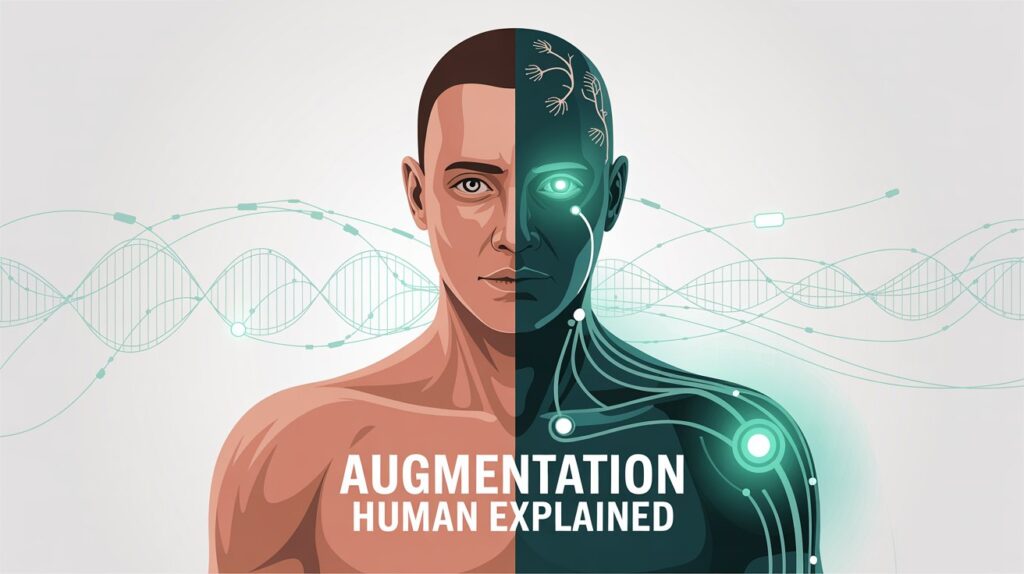Imagine losing your voice to ALS, then talking again at 32 words per minute thanks to a brain-computer implant — that happened in 2024. Or picture an eight-year-old getting a superhero-themed bionic arm that lets her tie her own shoes. Stories like these explain why searches for augmentation human have exploded. In plain English, the term describes any tech that restores or boosts the abilities of your body or mind. From injury recovery to elective “upgrades,” the field is moving fast enough that you need a clear, hype-free guide. That’s what this article delivers.
What does “augmentation human” actually mean?
Human augmentation is a spectrum:
| Level | Goal | Common Tech |
|---|---|---|
| Restorative | Bring you back to baseline after injury or illness | Cochlear implants, pacemakers, powered prosthetics |
| Enhancement | Push healthy abilities further | Exoskeletons that lift 200 lb, AR contact lenses |
| Elective Upgrade | Add new capabilities | Magnet or NFC chip implants, gene edits for rare traits |
The phrase augmentation human simply flips the order but keeps the meaning: technology integrated with the human body to restore, extend, or transform natural functions.
Brief timeline
- 1958 – First pacemaker implanted
- 1984 – FDA clears cochlear implant
- 2010s – 3-D printed prosthetics & CRISPR arrive
- 2020s – Commercial back-support exosuits, first CRISPR drug approved (Casgevy)
- Mid-2020s – Text-to-speech brain implants enter clinical use.
How it works: Four technology pillars
1. Biomechanical augmentation
Think bionic arms, lightweight leg prosthetics, and full-torso exosuits. The Hero Arm, for example, is now sold in 800-plus U.S. clinics and weighs just 12 oz.
2. Neuro-digital interfaces
Brain-computer interfaces (BCIs) translate neural signals into digital commands. In 2024 a Blackrock implant let an ALS patient speak again with only 2.5 % error.
3. Genetic & cellular engineering
CRISPR editing has moved from mice to medicine: Casgevy won approval in late 2023 for sickle-cell disease and beta-thalassemia, marking the first licensed CRISPR therapy.
4. Sensory & cognitive overlays
Augmented-reality (AR) contact lenses under development at Mojo Vision pack a 28,000-pixel-per-inch micro-LED into something the size of — yes — a lens.
Benefits: Why you might welcome augmentation
- Medical restoration – Advanced prosthetics can restore up to 80 % of grip function; cochlear implants routinely deliver speech comprehension above 90 %.
- Workplace safety & productivity – HeroWear exosuits cut warehouse back injuries from 1 per 27 k hours to zero over 280 k hours.
- Emergency response & defense – Exoskeletons let firefighters carry gear longer and soldiers run with less fatigue.
- Accessibility = “Super-ability” – Visual AR overlays help people with low vision read street signs; powered wheelchairs climb stairs.
- Economic growth – The global bionic-prosthetics market alone is forecast in the multi-billion-dollar range by 2025.
Risks & ethical concerns you can’t ignore
| Risk | Why it matters to you |
|---|---|
| Health & safety | Implant rejection, battery failures, gene-edit side effects |
| Security & privacy | BCIs and smart limbs can, in theory, be hacked for data or control |
| Upgrade divide | High costs (a top-tier bionic hand can hit $45 k) worsen inequality |
| Identity questions | Where do you end and the machine begin? |
| Legal gray zones | U.S. FDA rules differ from EU MDR; gene-editing laws vary by state |
Real-life examples in action
Open Bionics Hero Arm
Kids as young as eight are now tying shoelaces and riding bikes again. Open Bionics partners with donors to cut costs for families.
HeroWear Apex 2 Exosuit
Distribution centers logged 0 back injuries over 280,000 work-hours versus the historical 10-plus expected.
Blackrock Neurotech speech implant
A 45-year-old ALS patient talks at 32 wpm using a 125 k-word vocabulary — five times faster than his pre-implant board spelling.
Casgevy CRISPR therapy
First-ever gene-editing drug frees transfusion-dependent patients from hospital visits, hinting at one-shot cures for genetic diseases.
Mojo Vision AR lens
While still in prototype, Mojo’s micro-LED lens aims to layer navigational arrows or health stats right onto your field of view.
Future outlook: Five trends to watch
- Consumer neuro-wearables – Wrist-or head-mounted BCIs for gaming and productivity.
- Lab-grown organs on-demand – Bioprinting kidneys could slash transplant waitlists.
- Government ethics frameworks – OECD and WHO drafting global augmentation guidelines.
- Digital twins for surgery – Virtual models of your body to test implants before the scalpel.
- Elective “boosts” – Pay-per-use night-vision contacts or muscle-boost patches may hit gyms within a decade.
How you can prepare
- Do your homework. Check FDA approvals and clinical-trial registries before signing up.
- Ask about insurance. Some private plans now reimburse exosuits for on-the-job injury prevention.
- Upskill early. Roles that pair humans with exoskeletons or BCIs will value tech-savvy workers who can troubleshoot their own gear.
- Speak up. Push for equitable access so augmentation tech doesn’t become a luxury limited to a few.
Frequently asked questions
Is augmentation human legal in the U.S.?
Yes, if the device or therapy is FDA-cleared or used under an approved clinical trial.
How much does a modern bionic arm cost?
Anywhere from $8 k (entry myoelectric) to $45 k (AI-powered, multi-articulated).
Can implants be removed later?
Most mechanical and neural implants can, but gene edits are permanent.
Will employers force enhancements?
Current U.S. law bars mandatory medical procedures, but voluntary “performance incentives” could create soft pressure.
Conclusion
Human augmentation is no longer sci-fi; it’s in clinics, warehouses, and living rooms today. The upside is life-changing—if your spinal injury heals faster or your job gets safer, that’s a clear win. Yet every battery, microchip, or gene edit comes with trade-offs. Your best move? Stay informed, demand ethical safeguards, and keep the focus on tech that empowers you, not replaces you.

